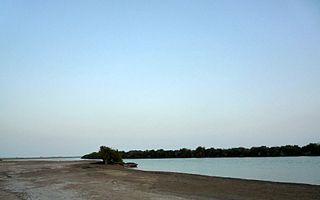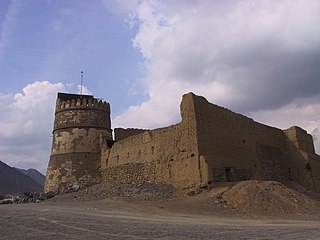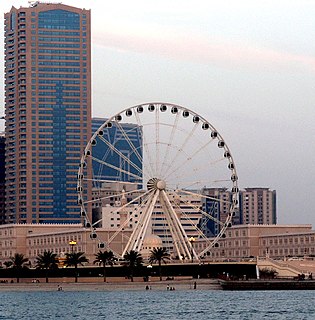| Sharqiyin | |
|---|---|
| Arab tribe | |
| Ethnicity | Arab |
| Location | United Arab Emirates |
| Language | Arabic |
| Religion | Islam |
The Sharqiyin (singular Al Sharqi) is a tribe of the United Arab Emirates (UAE). [1]
The Al Sharqi family is the ruling royal family of Fujairah, one of the seven emirates that together comprise the United Arab Emirates (UAE).

The United Arab Emirates, sometimes simply called the Emirates, is a country in Western Asia at the southeast end of the Arabian Peninsula on the Persian Gulf, bordering Oman to the east and Saudi Arabia to the south, as well as sharing maritime borders with Qatar to the west and Iran to the north. The sovereign constitutional monarchy is a federation of seven emirates consisting of Abu Dhabi, Ajman, Dubai, Fujairah, Ras Al Khaimah, Sharjah and Umm Al Quwain. Their boundaries are complex, with numerous enclaves within the various emirates. Each emirate is governed by a ruler; together, they jointly form the Federal Supreme Council. One of the rulers serves as the President of the United Arab Emirates. In 2013, the UAE's population was 9.2 million, of which 1.4 million are Emirati citizens and 7.8 million are expatriates.
Contents
The Sharqiyin were long the dominant tribe along the East coast of the Trucial States (and the second most numerous in the area around the start of the 19th century), an area known as Shamailiyah. [2] A 1968 census showed 90% of the tribal population of Fujairah was Sharqiyin. [3] They were traditionally dependents of Sharjah and, over the centuries, made several attempts to secede and declare independence, finally practically managing this from 1901 onwards [4] and finally gaining British recognition as a Trucial State, Fujairah, in 1952. [5]

The Trucial States was the name the British government gave to a group of tribal confederations in south-eastern Arabia which had been known as the "Pirate Coast". The name derived from the territories whose principal sheikhs had signed protective treaties with the British government from 1820 until 1892. They remained an informal British protectorate until the treaties were revoked on 1 December 1971. The following day six of the sheikhdoms formed the United Arab Emirates; the seventh – Ras Al Khaimah – joined the Federation on 10 February 1972.

Fujairah is one of the seven emirates that make up the United Arab Emirates. The only of the seven with a coastline solely on the Gulf of Oman and none on the Persian Gulf, its capital is Fujairah City.

Sharjah is the third largest and third most populous city in the United Arab Emirates, forming part of the Dubai-Sharjah-Ajman metropolitan area. It is located along the southern coast of the Persian Gulf on the Arabian Peninsula.
They settled all along the East Coast of the Trucial States, from Kalba to Dibba, as well as in the Wadi Ham and Jiri plain and by the turn of the 20th century they were some 7,000 strong. Three sections of the tribe are notable, the Hafaitat (from which the ruling family of Fujairah derives), the Yammahi and the Hamudiyin. [1] After the Bani Yas, the Sharqiyin were the second most numerous tribe in the Trucial States.

Kalba is a city in the Emirate of Sharjah in the United Arab Emirates (UAE). It is an exclave of Sharjah lying on the Gulf of Oman coast north of Oman. Khor Kalba, an important nature reserve and mangrove swamp, is located south of the town by the Omani border. The town was captured by the Portuguese Empire in the 16th century and was referred to as Ghallah.
Dibbā is a coastal area at the northern tip of the eastern Arabian peninsula on the Gulf of Oman. It is politically divided into three segments:

Wadi Ham is a wadi in Fujairah, United Arab Emirates.


